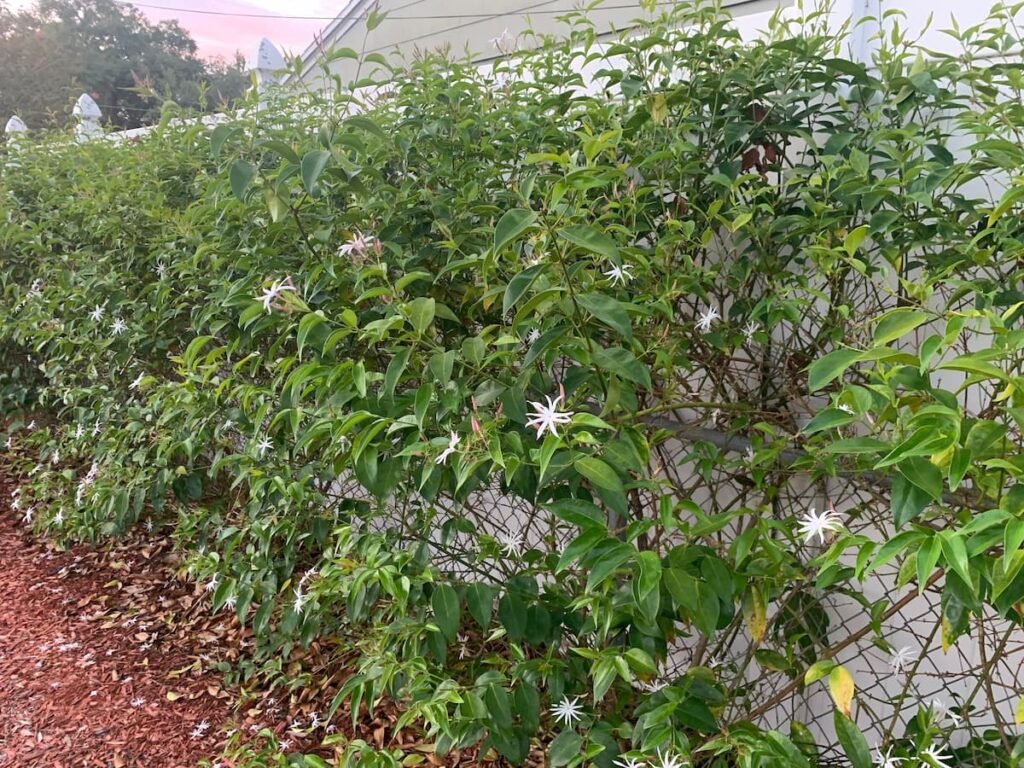I love planting jasmine shrubs and vines… I’ve loved their blissfully fragrant smell forever. But I didn’t know what plant produced that special scent until some words from a popular Seals & Croft tune made me look it up. “Summer breeze, makes me feel fine / Blowing through the jasmine in my mind.”
Those of you of a certain age know what song this is. It’s “Summer Breeze,” and it was a hit for the soft rock duo in 1972. It was still a ubiquitous song on the radio and grocery store playlists when I was growing up many years later into the 1980s and ‘90s. And I just had to know what “jasmine” was.
Well, when I learned that James Eugene Seals and Darrell George “Dash” Croft were referencing an aromatherapeutic plant with an intoxicating smell, I just had to find this jasmine and take a whiff myself. And there it was – the flower smell I had enjoyed all my young life but never knew its origin. At the time I didn’t really have a place to grow jasmine. My family and I lived in a rental apartment and my gardening space was too small for planting jasmine.
Planting Jasmine In My Yard
I didn’t get to grow jasmine in earnest until I bought my first home in 2018. I planted several examples of Jasminum laurifolium, known as angelwing jasmine and often called star jasmine — the latter of which I’ll be referring to my jasmine here. It’s native to Asia but grows very well in Florida (where I currently live) and California.
Star jasmine is a vine-y shrub that grows about 10 feet tall and spreads out three to five feet. It’s perfect for obscuring a 36-inch-tall chain link fence along one of my property lines. And it provides a beautiful, fragrant buffer between my backyard and the neighbor’s six-foot-tall vinyl fencing. The dark green leaves tie in well with the lawn grass, while the white flowers look pretty dappling the green foliage along the white fence.

Jasmine flowers produce a sweet, fruity scent that verges on a little musky or spicy. The rich, distinctive fragrance is used in many perfumes, scented candles, and aromatherapy mediums.
My Tips For Planting Jasmine
I’ve now had jasmine growing for several years and have had ups and downs with these plants. They’ve survived frosts and freezes. They’ve eked through too-hot afternoons and wilt-inducing droughts. And they’ve lived glory days in the late spring and early summer when their blooming flowers make the whole yard smell heavenly.
I’ve learned a thing or two about planting jasmine and how to keep them thriving. So, I want to share what I’ve learned – often through trial and error – with you.
Plant The Right Type Of Jasmine For Your Hardiness Zone
Jasmine is generally a warm-weather plant that grows best in USDA Hardiness Zones 8-10. However, there are winter-hardy varieties that can thrive in northern climes. For example, winter jasmine (Jasminum nudiflorum) can grow well in the landscape as far north as USDA Zone 6. My Central Florida home is in Zone 9B, so I’m smack dab in the middle of jasmine’s happy place.
Planting Jasmine In Full Sun To Partial Shade Is Ideal
Specific jasmine varieties have their own growing requirements. Yet, most do well in full sun to partial shade in well-drained soil. My star jasmine grows in a full-sun location that receives six to eight hours of direct sunlight daily. Their bed is also slightly elevated from the surrounding yard, ensuring water doesn’t pool around their bases.

Prune Jasmines After They Flower
The best time to prune jasmine comes down to what variety you have and when it blooms. I usually prune my star jasmine after they finish flowering. Pruning them then encourages denser growth and helps prepare them for flowering again. At my place, this usually occurs over the course of a couple cycles that span from late spring into early summer.
Prevent Heat Stress With Watering During Hot Spells
I’ll admit, I was a little taken aback after planting jasmine only to soon find it suffering from heat stress going into their first summer. I mistakenly thought jasmine was more drought and heat tolerant than that. This led me to thoroughly watering my jasmine plants early in the mornings during hot dry spells. They seem to fare well enough now that I’m watering them regularly throughout the week between rainy periods.
…And Keep Your Jasmine Safe During Frosts and Freezes
It seems most people not from Florida think it never gets cold here. WRONG! It even snows here – rarely, but it does. In my neck of the woods, we can expect at least a few frosty mornings and one good freeze a year – maybe two. That means that I need to keep my star jasmine safe during cold snaps. I learned this the hard way a few years ago when we got down into the 20s one morning and I found my jasmines browning and limp.

I cut them back to the ground and, come early spring, they were sprouting again like there was no tomorrow. My fence was covered with beautiful jasmine once more by the end of the summer!
